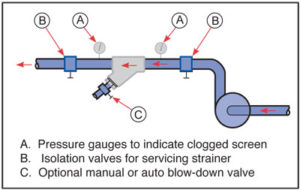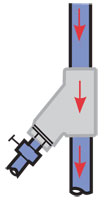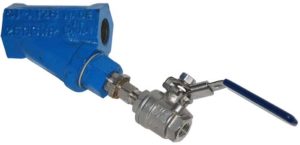If you spend much time on our website you’ll notice it’s full of some pretty impressive products. Over the decades our product line has grown, and our manufacturing and fabrication services and capabilities have grown to meet our customers’ growing demands. A brief look through our “Product Gallery” section shows we make some exceptional strainers and valves.
As the world gets more complex it’s easy to get distracted from some of the simple amazing things in our lives. Like turning on a tap and having clean water come out, opening a fridge and taking out a cold drink, or turning the ignition key in your car, and having this marvelous compilation of steel and copper and rubber and integrated circuits move you from Point A to Point B in comfort.
It’s important to remember some of the simpler things that make this all possible, and with that in mind we’ve decided to feature some of the products that may not seem ultra-sophisticated but which make the processes we require in modern life work better and more efficiently. One of those is a simple “Y Strainer”.
A “Y Strainer” takes its name from its configuration and is most commonly used in pressurized lines, gas or liquid. They can also be used in suction or vacuum conditions. Y Strainers are intended for applications where small amounts of solid particulate are expected and where clean-out will be infrequent. If solids will flush easily from the screen, and fluid can be exhausted to atmosphere, a blow-down valve on the drain port will allow clean-out without removal of the screen, and without interrupting the process flow.
By definition a strainer provides a means of mechanically removing solids from a flowing liquid. They do this by utilizing a perforated metal, mesh or wedge wire straining element.
We often forget that installation of a Y Strainer isn’t an expense, it’s an investment in the protection of the downstream mechanical equipment such as turbines, pumps, heat exchangers, spray nozzles, condensers, meters and steam traps. These are often one of the costliest components of the process and can be damaged by sediment, rust, pipe scale and other extraneous debris.
Y Strainers can be used in either a horizontal or vertical position while most basket strainers are designed for horizontal or slightly inclined piping applications. You must pay attention to the orientation of the chamber which collects debris and the drain (blow-down) connection of the Y Strainer. The strainer must be installed so that it is in the lowest possible position.

A Y Strainer installed in vertical piping must be installed so that its screen is in the downward position so that it can trap sediment in the debris collection chamber.

A simplex strainer (just a single strainer as opposed to a duplex strainer) is generally used where the process can be shut down for a period of time to replace, or to clean the strainer.
Y Strainers and many basket strainers can be self-cleaning. If you add a blow-down valve the strainer can be flushed without stopping the flow through or disassembling the piping.

Contractors and engineers often have a misconception that Y strainers and basket strainers cannot be used in steam service. In many instances both basket strainers and Y Strainers will perform comparably in steam service. When you order strainers for steam service it’s essential that you specify this so the manufacturer is aware of this. With steam the housing may be provided with a special bottom which allows the accumulated debris to be blown out of the blowdown valve opening.
When liquid flows through a strainer, the strainer screen will impede the flow and therefore the pressure of the liquid exiting the strainer will be lower than prior to entering the strainer. This is referred to as the “pressure drop” of the strainer.
In sizes about 4 inches, a basket strainer will generally create less pressure drop than a Y strainer. Due to the required thickness and therefore high cost to create high pressure strainers, basket strainers are normally not constructed for pressures above 1,500 psi. On the other hand, Y strainers are available for working pressures of 6,000 psi and higher.
Cast Y strainers can be installed into a pipeline or work flow application either by “threading” them on to a piece of pipe, or by being bolted to a “flange”.
Threaded cast Y strainers can come in a variety of materials including Cast Iron, Cast Bronze, Cast Steel, Cast Stainless Steel, Cast Alloy 20, Cast Chrome-Moly. Flanged Y Strainers can come in Cast Iron, Cast Ductile Iron, Cast Steel, Cast Stainless Steel, Cast LCC.
While Y strainers are not always the flashiest part of production process they are an essential component. In an era where we have the tools to analyze and record in minute detail variables including downtime, make sure you keep those expensive downstream components working to their potential by ensuring you are removing the debris and particulate that can reduce their efficiency or cause premature failure.

